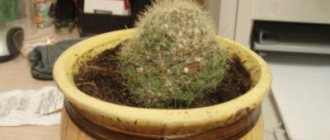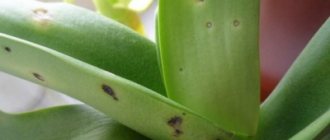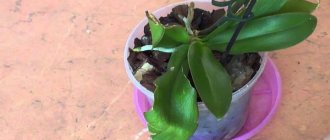Plants » Flowers
0
1459
Article rating
Kira Stoletova
Most orchids are known for being capricious, and therefore require increased attention from the grower. A common problem is that orchid roots dry out and wither. To save a flower from death, decisive action must be taken.
How to help an orchid with dry roots
Why did the aerial and internal root systems dry out?
The orchid looks quite healthy in appearance and seems to be doing well. It blooms and smells fragrant. But during transplantation it suddenly turns out that the roots look somehow wrong. Lethargic, weakened. This is a sign that they are drying out on the plant.
First of all, you need to figure out which roots are damaged, the aerial ones - those above the pot, or the internal ones - those inside the pot.
Basically, this is the result of improper orchid care:
- Watering. You need to pay attention to the color of the roots. Healthy ones have a light green tint. If they have acquired a slightly grayish tone, then the plant needs watering. Lack of water causes them to dry out.
- Humidity. Excessive moisture will cause the flower to rot, fungus to form and die.
- Watering with hard water. In this case, the root system is covered with a brown coating, and the substrate is white. This suggests that too much salt has burned the roots. The air units suffer more in this case.
- Fertilizer dosage. Not following the rules for using them. Excess leads to burns. As for feeding, the main rule when using them is: it is better to under-feed than to over-feed.
- Mechanical injuries. When transplanting from one pot to another (bare roots are not protected and are fragile, easily injured). Plants are injured during moving and due to careless handling.
- Fungal or other infections. The first symptoms of these diseases are drying out of the root system and rot.
- Flower age. The older the age, the greater the likelihood of the orchid dying.
Problematic roots are one of the symptoms. The average age of a flower is 11-16 years, after which the flower rejuvenates or dies completely.
All these phenomena can subsequently lead to drying out of the plant roots. It is very important to identify the problem in time and cure the flower. The problems are solvable and easy to treat. Lost time and mistakes made lead to the death of the plant.
Phalaenopsis resuscitation methods
There are several ways to correct the situation. One of them is water softening using improvised methods, for example, peat or wood ash. To do this, you need to dissolve 3 g of ash in a liter of tap water. If peat is used as a softener, then you need to add 10 g.
You can moisten the roots with soft nutritious fertilizers. To prepare them you will need glucose and honey, 1 tsp each. They are mixed in 1 liter of water and the substrate is moistened with this solution.
If the root system is significantly damaged, it is necessary to trim all dry roots. The instrument must be sterile. It is important to cauterize the sections. If the roots are completely cut off, you can temporarily plant the orchid in moss to form new roots.
You should not ignore special preparations for the formation of roots, for example, kornevin. It stimulates the growth of remaining roots and creates conditions for the formation of young shoots.
Experienced gardeners often use the double pot method to retain moisture. The essence of this device is that an ordinary pot is placed in another container, and drainage is placed on the bottom between them and water is added. This allows you to retain moisture for a long time.
Photo
The photo shows what dried roots look like.
Overheat
The orchid does not like direct sunlight and hot radiators. If the leaves of a phalaenopsis wither, you need to check the air temperature in the room; the plant may have overheated.
In addition to the sun, heating comes from heated glass if the pot is on the windowsill. The leaves begin to actively evaporate moisture, the substrate heats up, and evaporation occurs in the pot. The roots experience a lack of moisture and cool down as the heat of the substrate is spent on evaporation.
In summer, the maximum air temperature for an orchid is 25°C. If limp leaves are found on the orchid, the pot should be moved to partial shade or another less hot place.
It is necessary to take measures to save the orchid immediately, otherwise the plant will quickly die; in a matter of days it can dry out completely; both the roots and the ground part will dry out to the same extent.
If the plant has been overheated for a short time, a period of several hours to several days will be enough for it to recover on its own. It is forbidden to spray the plant when it is under the sun's rays - this will cause the leaves to get burned. Spraying in summer is effective only in the evening.
When the plant is in the shade and the temperature of the roots and ground parts is equalized, the orchid can be wiped with a damp sponge and watered. To speed up recovery, add succinic acid or a drop of Epin to the water.
What to do for rescue and care at home
There are a number of main reasons why all the roots have dried up, namely why the root system died from above and below. Find out all the nuances that will help you cope with the problem and what needs to be done with dried roots.
Hard water burn
Aerial roots are mainly affected. Orchids are hardy plants. The flower functions due to the internal root system. Soon healthy buds grow on their own.
Water for irrigation should be soft.
There are several ways to soften water:
- Filtration. It is important to choose the right filter and cartridge, otherwise there will be no effect. They must be special to soften water. The method is expensive, but provides maximum results.
- Add wood ash or fresh peat. 100 grams of peat per 10 liters of water. The ash should be exactly 3 grams of wood ash per liter of water.
Fertilizer burn
- Begin treatment by soaking the roots and neck in clean water. Every day up to 1.5-2.5 hours. Repeat the procedure until new buds appear.
- Then transplant the flower into another substrate without fertilizers, after cutting off the affected roots.
Use half the recommended dose of fertilizers, and universal ones - three times less.
Water shortage
- Watering should be done moderately. A deficiency will lead to diseases of the root system. Do not rely on any intervals in watering. If the upper layers of the substrate are dry, the plant asks for water.
- Soak the roots in a 0.1% solution of succinic acid for 40-60 minutes.
Low air humidity
The orchid loves a humid environment; air circulation is needed between the roots. The substrate should be loose, but not dense. If there is insufficient air humidity, it is recommended:
- buy an air humidifier;
- place the flower in the florarium;
- place an aquarium or fountain next to the plant;
- regularly spray the space around the plant with a spray bottle;
- hang wet towels on heating radiators;
- place the pot in a tray with wet filler (pebbles, moss, expanded clay).
The larger the pan, the more moisture evaporates. Tray for cats, the most convenient stand.
Infectious diseases
This is the most serious problem that requires long-term treatment and serious treatment. Remove the orchid from the soil and inspect the roots through the transparent pot:
- Healthy roots are dense, light, and elastic. Greenish without plaque and yellow roots.
- Patients are brown, mucous, and when pressed, a cloudy liquid is released.
Treatment:
- Remove all affected roots.
- Treat the cuts with crushed activated carbon.
- Plant in a new pot.
- Wipe affected leaves daily with succinic acid.
Causing mechanical injuries
Over time, cracks and scratches heal on their own with mechanical tissue.
If during transplantation most of the root system is lost, you need to cut off some of the leaves. This makes it easier for the roots to feed the flower. The procedure for cutting green mass:
- disinfect the instrument;
- cut off the lower old leaves;
- treat cut areas with powdered activated carbon;
- do not feed at first;
- watering once a week.
The best varieties of orchids
The orchid is a delicate creature, of various shapes and incredible shades. It differs not only in external qualities, but also in size:
- The first group is represented by shrubs whose flower stalks are located in a horizontal position. Over time, the sprouts are able to transform into pseudobulbs, which accumulate a significant amount of moisture and beneficial microelements.
- Monopodial plants are orchids with a pronounced main peduncle on which a large number of inflorescences are located. They gradually open up and completely fill the entire space of the arrow.
Each type of exotic bush is demanding in terms of care, growth and cultivation characteristics. The following are the best varieties of orchids that are popular among the population:
- Aganisia is a rare plant that is practically not grown indoors. It differs from others in the unusual shapes of leaves and peduncles.
- Angrekum Leonis - has a pleasant, non-persistent aroma, produces flowers of interesting shape and large size. The inflorescences have pastel colors, up to a matte ivory shade.
- Phalaenopsis is the most common exotic plant in Russia; it lives well in indoor conditions. With quality care it grows within 6-7 years. It does not have a specific dormant period; under favorable circumstances, it blooms for 6-9 months.
- Vanda - like Phalaenopsis, is widespread. Its stem can stretch up to 2 meters, and the root system can spread in breadth. It does not have a long flowering period - the inflorescences last for 1.-3 months. The flowers, especially at night, give off a pleasant, delicate aroma with a hint of caramel.
- Cattleya - can be either miniature, even dwarf, or huge in size. It is impossible to buy this type in the store, only in case of a special order. And it’s not a fact that an original exotic plant will come, and not a hybrid.
- Dendrobium is a diverse species representative of shrubs. It has unusual colors and flower shapes. Inflorescences reach 5-8 cm in diameter. With quality care, it has the opportunity to bloom 2 times a year - in the summer months and winter days.
Thus, the orchid has many types. In living nature there are more than 70 types of its representatives. But not all of them can grow in a temperate climate and cannot be grown at home.
When can a plant no longer be saved?
If upon inspection there is not a single leaf on the orchid, it has no roots at all or they are severely damaged by rot and then do not despair. At any stage, the flower can be revived. You just need to choose the right treatment.
If all the roots of the orchid are dry, you need to treat the root neck with root and place it in moss or sphagnum. Moisten regularly with water. After at least five roots appear, replant the substrate.
Dense substrate
Air should always circulate between the roots of the orchid. This is a prerequisite for the flower, in addition to the moist environment in the pot. If your phalaenopsis leaves are wrinkled, the cause may be a dense substrate.
The substrate for the orchid should be loose.
The loose substrate provides ventilation for the roots, they remain healthy and do not rot, and excess moisture is easily removed. If the orchid withers, it means that these conditions are not met.
The cause of leaf wilting is eliminated by completely replacing the substrate. Properly processed, high-quality bark easily absorbs water, filtering it through its pores.
Prevention
- Maintaining a constant temperature in summer +21-25°, in winter +15-18°.
Changes up to +5° are allowed. - Provide up to 14 hours of daylight using diffused lighting.
- Select the size of the pot.
- Regular ventilation, maintain room humidity at 50-60%.
- Change the substrate every 2-3 years.
- Water once a week, and in between allow the roots to dry completely.
- Water temperature for irrigation is 35-40°.
- Spray up to five times a day. Do not spray during flowering period.
The tropical beauty was pleasing to the eye, and you took care of her with pleasure, but suddenly she began to dry out. Why is this happening and what to do? Our experts have prepared articles about the reasons for the drying of the stem, flowers and leaves, and you will also learn about methods for saving the plant.
If the roots of an orchid have dried out, do not rush to part with it. Even without roots, she will find the strength to survive. With proper treatment, you can awaken dormant buds and give life to a new root system.
How to identify the problem?
It is difficult to determine from the appearance of the plant whether the roots of the flower have dried out. To do this, you should conduct a more detailed inspection of the orchid’s root system by removing it from the pot. It is also necessary to remember that a healthy plant has roots with a dense structure and elasticity.
If a flower has an increase in the number of aerial roots, this also indicates a lack of humidity in the room. If spots, bumps, or ulcers appear on the plant, this indicates the presence of infectious diseases.











